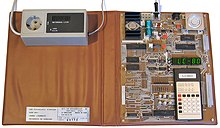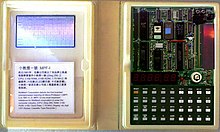Single board computer
A single board computer , often English. single-board computer (SBC) is a computer system in which all electronic components required for operation are combined on a single circuit board . Typically, the power supply is the only component housed separately. They are used in many areas of application - e.g. B. in industry, in electronically controlled commodities and in the private and hobby sector.
Basics
Devices like the KIM-1 , the Microprofessor I and the Apple I formed one of the preliminary stages of the later home and personal computers from the mid-1970s . They were often built and used by computer enthusiasts and hackers , but later their prevalence among private users declined sharply. From a constructive point of view, most of the home computers of the 1980s such as the Sinclair ZX81 , the Commodore 64 or the Atari ST can also be viewed as single-board computers, but were usually not designated as such.
Single board computers are used in industry mainly in the measurement - control and - control technology used (MSR). They replace hard-wired controls in many areas, since changes to the control processes can be implemented simply by modifying the program , and at the same time they are cheaper than complex programmable logic controllers (PLC). So-called embedded systems are also an important application in electronically controlled commodities such as household appliances , motor vehicles, WLAN routers , entertainment electronics devices or medical technology . Adapted variants of the Linux operating system are often used today (such as embedded Linux ).
Since around 2012, single-board computers have become increasingly popular again in the private sector, especially the Raspberry Pi with 5 million copies sold (as of February 2015). They are used, for example, as an inexpensive media center , home server , as a school computer or as an experimental device under Linux (e.g. Android ).
construction
A single-board computer consists at least of the actual processor , a clock generator , a reset logic, a read-only memory ( ROM ) for the program and input and output modules. With this equipment, simple sequence controls can be implemented. For more complex tasks, additional components are required, primarily RAM in order to be able to store intermediate results or execute subroutines, and EEPROM or flash memory for variable parameters that have to survive a power failure.
Very often, single-board computers are provided with monitoring circuits ( power failure detection , watchdog ) that reset the computer to a defined initial state in the event of an unexpected error in the program or in the power supply.
Furthermore, single-board computers with analog-to-digital converters , counter modules, communication interfaces and other special circuits can be adapted to the respective application.
History of professional application
Single-board computers came onto the market in the late 1970s with the proliferation of microprocessors . They initially covered the need for inexpensive development systems , but were also designed from the outset to be used in productive environments. They are used in industry mainly in measurement -, control and - control technology used (MSR). In many areas, you can advantageously replace hard-wired controls , since changes to the control processes can be implemented in most cases by simply exchanging the program . At the same time, they are much cheaper than programmable logic controllers (PLC) and can therefore be used economically in areas for which a large PLC would be oversized.
With the advancing development of the microcontroller , which combined more and more functions in one chip in addition to the actual processor core, the range of applications also expanded. Today the descendants of the single-board computers can be found in washing machines, automatic transmissions , remote controls , heating controls and countless other devices of daily and industrial use. In the process, the small computers developed to ever greater efficiency, also with 16-bit and 32-bit processors, as well as in the direction of tiny minimal systems with only a few, simple functions ( BASIC postage stamp ).
Variants and designs
Many home computers , such as B the C64 or the Sinclair ZX81 , from a construction point of view, are also single-board computers with integrated video output, supplemented by a keyboard, additional controls, connections for peripheral devices and mostly some form of mass storage device - without these extensions, however, they cannot be used meaningfully. Modern smartphones and tablet computers also contain single-board computers built into a housing - mostly based on ARM microprocessors - but are also not given that name.
6502 single board computer
In the early computer development based on microprocessors, the 6502 CPU and its derivatives were very common, for example the Apple I , KIM-1 , SYM-1 and AIM-65 models .
A kit based on the 6502 CPU was presented by Elektor Verlag as a junior computer in May 1980 and, with several thousand copies, has become a popular do-it-yourself computer in Europe. The junior computer was developed at Elektor by Loys Nachtmann, who later moved to Chip magazine as editor .
Further examples are the DIY computer Cobold , the EMUF presented in 1981 by the magazine MC and the CEPAC-65 presented in 1984 in the c't , which was suitable as a universal control computer.
8085 single board computer
Single-board computers were also available with the Intel 8085 processor, for example the ECB85 experimental computer from Siemens, which came on the market in 1979.
SC / MP single-board computer
An early do-it-yourself computer was published by Elektor Verlag in June 1977 (G 3078EX) based on the SC / MP (Type I). Another kit was launched on the market in 1978 by the electronics manufacturer and teaching material provider Christiani-Verlag from Konstanz as the SC / MP teaching computer.
Z80 single board computer
As one of the first single-board computers available in Germany, the Nascom 1, based on the Zilog Z80 CPU, came onto the market in 1977 . The first computers from the English manufacturer Sinclair Research , the Sinclair ZX80 and ZX81 as well as the ZX-Spectrum series, were also single-board computers. On the basis of Z80-compatible CPUs, further single-board computers (so-called SBC) have been implemented, so u. a. the NDR-Klein-Computer from 1984 by Rolf-Dieter Klein and the Euro-Z80 (Elektor-Verlag) from 1989. The Z80- EMUF (single-board microcomputer for universal fixed- value program application) is also a common single-board type in Been self-made. Since Zilog's Z80 processor is still available today, new systems with clock rates of 20 MHz are currently being developed.
Today's single-board computers

Until the 1990s, 8-bit single-board computers, e.g. As with Intel 8085 processor, Intel MCS-51 - microcontrollers and their successors, used to meter control rule purposes (MSR). Today, single-board computers are equipped with more powerful microcontrollers and cover the various needs for household, industrial, automotive and military purposes as an embedded system . The trend is towards integrating more and more functions (standard interfaces, A / D converters, etc., up to complete WLAN functions including TCP / IP stack) of the single-board computer directly on the same chip as the CPU (see System-on -a chip ). As a result, the unit price of these computers can be reduced with increasing functionality.
Well-known current single-board computers for end users include Arduino , BeagleBoard , Cubieboard , Ethernut , PandaBoard , Raspberry Pi , Tinkerforge , Banana Pi , pcDuino , Orange Pi , ODROID , NanoPC , HummingBoard and the BBC micro: bit designed for educational purposes . Such computers are about as a music streaming client , media center , thin client or server , as a control board in a Quadrocopter when weather station , VHF - radio station or a control unit for dedicated Bitcoin used -Mining hardware.
See also
Web links
- Single board computer , private website
Individual evidence
- ↑ Peter Piksa's blog, How my Raspberry Pi turns my solar power into bitcoins. (No longer available online.) Archived from the original on October 4, 2013 ; Retrieved October 4, 2013 .




